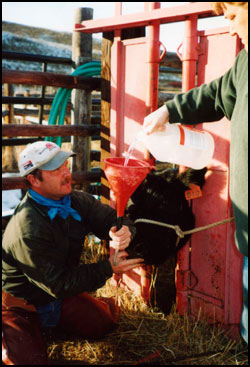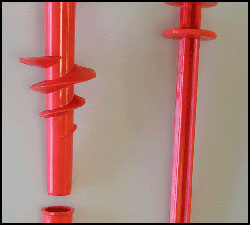Dealing With Pasture Bloat

The preferred therapy for pasture bloat, if caught in time, is to administer mineral oil or poloxalene via stomach tube into the rumen.
"Bloat occurs when rumen gas production exceeds the rate of gas elimination," explains Stephen Boyles, Ohio State University (OSU) beef extension specialist. "The gas accumulates and causes distention of the rumen (left side of cattle). If the situation continues, the inflated rumen interferes with respiration."
"Cattle in trouble stand with head and neck extended, open-mouthed and drooling," describes David Van Metre, veterinarian and associate professor within the Colorado State University College of Veterinary Medicine and Biomedical Sciences. "They are too busy trying to breathe to swallow, and they drool saliva. When they become short on oxygen, they stagger and go down."
At this point, you must take immediate action to let gas out of the rumen, he explains, by "sticking" the distended rumen with a knife or trocar to prevent suffocation.
"Preferred therapy is to administer mineral oil or poloxalene via stomach tube into the rumen, but cattle may be too far from a holding facility where you can get a stomach tube safely into the animal," Van Metre says.

David Van Metre
"I've seen [fewer] problems with peritonitis if a person uses one of the new screw-in self-retaining plastic corkscrew trocars. The outside is threaded. When you screw it all the way in it tends to hold the rumen next to the abdominal wall as gas escapes and the rumen shrinks, with less leakage of rumen contents into the abdominal cavity."
If it's frothy bloat rather than gas, the trocar cannula may plug. Then you must put mineral oil or poloxalene (Therabloat®) directly into the rumen via the cannula, Van Metre says. "Some people use laundry detergent because it breaks up the froth."
Bloat may be more likely in early morning because protein content of forage is higher, and cattle are hungry because they haven't been eating during the night. Dewy forage is risky because cattle don't have to mix much saliva with wet feed for chewing and swallowing. Saliva contains compounds that reduce gas and froth development in the rumen.

The new screw-in self-retaining plastic corkscrew trocars can help prevent peritonitis by holding the rumen next to the abdominal wall as gas escapes and the rumen shrinks, allowing less leakage of rumen contents into the abdominal cavity.
Some animals seem more prone to bloating, Van Metre says. "Researchers analyzed saliva from cattle and found subtle differences in salivary proteins that might limit froth formation in the rumen. This may help explain why some animals bloat more readily than others."
A chronic bloater may have other issues that affect rumen function. Lengthy pneumonia may cause enlargement of lymph nodes surrounding the esophagus. "These nodes may put pressure against the esophagus, making it narrower, and hinder burping. The animal may have an enlarged rumen all the time. Some bloaters get better after a course of antibiotics," he explains.
Click here to read an OSU fact sheet authored by Boyle that describes pasture bloat, lists forages according to risk of bloat and offers tips to prevent bloat on pasture.

[Click here to go to the top of the page.]











